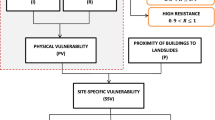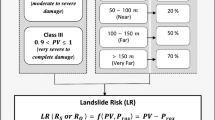Abstract
Building vulnerability evaluation is important in the risk assessment on earthquake and flood hazards. But for landslide hazard, it is also a very important part for the people in buildings. Most discussions or researches about building vulnerability are for landslide failure, few for landslide in deformation phase. For this objective, this paper discussed about building vulnerability evaluation using Zhaoshuling landslide as an example Zhaoshuling landslide named located in the Three Gorges Reservoir Area, China. After a field survey on the geological condition of landslide, detailed field investigation on the buildings’ location and structure is carried out. To get landslide surface deformation, numerical simulation method is used under the combining condition of water fluctuation and rainfall. Then building deformation and probable damage degree is analyzed according to landslide surface deformation and the relative theory in mining. Based on the national standard building damage classification system, the vulnerability of all the buildings on the landslide is semi-quantitatively evaluated.
Similar content being viewed by others
References
Barbolini M, Cappabianca F, Sailer R (2004) Empirical estimate of vulnerability relations for use in snow avalanche risk assessment. Risk Analysis IV: 533–542.
Bell R, Glade T (2004) Quantitative risk analysis for landslides—Examples from Bildudalur, NW-Iceland. Natural Hazards and Earth System Sciences 4:117–131.
Cardinali M, Reichenbach P, Guzzetti F, et al. (2002) A geomorphological approach to the estimation of landslide hazards and risks in Umbria, Central Italy. Natural Hazards and Earth System Sciences 2:57–72.
China Coal Industry Bureau (2000) Pillar Establishing and Mining Standards for Building, Water Body, Railway and Main Tunnel. Beijing: China Coal Industry Publishing House. (In Chinese)
Crozier, MJ and Glade, T (2005) Landslide hazard and risk: issues, concepts and approach. In: T. Glade, M. Anderson, M.J. Crozier (eds.), Landslide Hazard and Risk. Wiley. pp 1–40
Deng KZ, Guo GL, Tan ZX et al. (2001) Analysis of movement and deformation characteristics of buildings above mining subsidence areas. Journal of China University of Mining and Technology 30(4):354–358 (In Chinese)
Fell R, Ho K, Lacasse S et al. (2005) A framework for landslide risk assessment and management. In: Hungr O, Fell R, Couture et al. (eds.), Landslide Risk Management. London: Taylor & Francis Group: 3–26
Galli M, Guzzetti F (2007) Landslide vulnerability criteria: a case study from Umbria, Central Italy. Environmental Management 40:649–665.
Haugen ED, Kaynia AM (2008) Vulnerability of structures impacted by debris flow. In: The 10th International Symposium on Landslides and Engineered Slopes. Xi’an, China.
Hollenstein K (2004) The role of administrative bodies in landslide risk assessment. In: T. Glade, M. Anderson & M.J. Crozier (eds.), Landslide Hazard and Risk. Wiley. pp 285–310
Hungr O (1981) Dynamics of Rock Avalanches and Other Types of Slope Movements. PhD Thesis, University of Alberta: 506
Luo YH (2000) Risk assessment of damage losses by debris flow. Land and Resource Management 17(5):6–9. (In Chinese)
Reichenbach P, Galli M, Cardinali M (2005) Geomorphological mapping to assess landslide risk: concepts, methods and applications in the Umbria region of central Italy. In: Glade T, Anderson M, Crozier MJ (eds.), Landslide Hazard and Risk. Wiley. pp 429–468
Tan ZX, Liu GQ, Zhang MK et al. (2007) Study on movement and deformation law of buildings in mining area by observation. China Safety Science Journal 17(2):44–49. (In Chinese)
Tang C, Zhang J, Zhou CH et al. (2005) Vulnerability assessment of urban debris flow hazard. Journal of Catastrophology 20(2):11–17. (In Chinese)
Yin KL (2004) Landslide Prediction and Risk Assessment. Wuhan: China University of Geosciences Press. (in Chinese)
Zhang L, Zhang YC, Luo YH et al. (1998) Theory and Practice of Geohazard Risk Assessment. Beijing: Geological Publishing House. (In Chinese)
Zhou GQ, Cui JX, Liu GR et al. (1983) Coal Mining Under Buildings. Beijing: China Coal Industry Publishing House. (In Chinese)
Author information
Authors and Affiliations
Corresponding author
Rights and permissions
About this article
Cite this article
Chen, L.X., Yin, K.L. & Dai, Y.X. Building vulnerability evaluation in landslide deformation phase. J. Mt. Sci. 8, 286–295 (2011). https://doi.org/10.1007/s11629-011-2101-z
Received:
Accepted:
Published:
Issue Date:
DOI: https://doi.org/10.1007/s11629-011-2101-z




